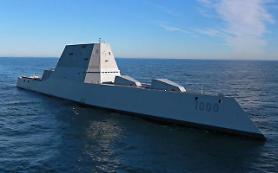
[Courtesy of Rolls-Royce Holdings]
SEOUL -- A new MT30 gas turbine designed by Rolls-Royce Holdings has been selected for the third batch of frigates to be built under South Korea's three-stage FFX warship program, demonstrating the technical superiority of the British engineering company which already has introduced a hybrid propulsion system for Daegu-class frigates.
The FFX program calls for the construction of six 2,300-ton Incheon-class ships for the first batch, eight Daegu-class ships for the second batch and six Ulsan-class ships for the third batch to replace the aging fleet of corvettes and frigates. The first FFX frigate was launched in 2011.
Rolls-Royce has already introduced a hybrid propulsion system for all eight Daegu-class Batch II frigates, each powered by a single MT30 gas turbine and electric propulsion motors. The hybrid propulsion system is designed to avoid detection by submarines. The Batch II frigate, which displaces 2,800 tons, is 122 meters long and can accommodate a helicopter.
For Batch III frigates to be built by Hyundai Heavy Industries, the world's largest shipbuilder, Rolls-Royce said it would use engine health management technology that delivers through-life benefits, such as reduced manpower and maintenance costs by enabling the collection of reliable engine data and analysis. The 129-meter-long Batch III frigate displaces 3,500 tons and can sail at a speed of 30 knots with 120 personnel on board.
The MT30 gas turbine, which is already in service with naval vessels in the United States, Britain and Italy, will deliver "game-changing military capability" in South Korea's next-generation destroyer program, Rolls-Royce said in a statement, adding its turbine was proven at sea, delivering long-term reliability, unrivaled life-long performance with operating cost efficiencies.
The first Batch III frigate with powerful radars and an electro-optical targeting system is scheduled to enter service in 2024. It will be armed with a five-inch main gun and missiles including Haegung (sea bow) which was designed to intercept missiles and aircraft. Haegung, equipped with a dual detector system, active radar guidance and infrared detector, has been related to the development of Cheongung, a surface-to-air missile (SAM) system.
South Korea has strived to develop an independent aerial and missile defense system, based mainly on Russian technology. A low-tier missile defense system has been almost completed. The Cheolmae-2 (Cheongung) middle-tier missile defense system, which can intercept targets at an altitude of up to 40 km, has been compared to American Patriot systems. A complete battery consists of up to six transporter erector launchers, an X-band 3D radar, and a fire command vehicle.
The Cheolmae 4-H L-SAM, based on the Russian S-400 technology, is an upper-tier interceptor to offer capabilities similar to that of the Terminal High Altitude Area Defense (THAAD) system, an advanced missile shield deployed by American troops in South Korea.
Copyright ⓒ Aju Press All rights reserved.

![[FOCUS] S. Korea under pressure to take inevitable choice against military buildup by China and Japan](https://image.ajunews.com/content/image/2020/11/12/20201112144822908694_278_163.jpg)

